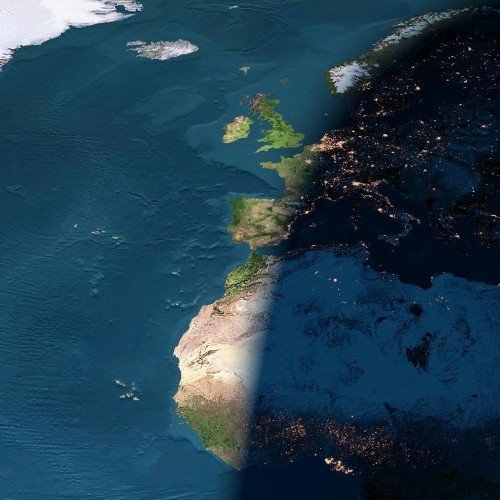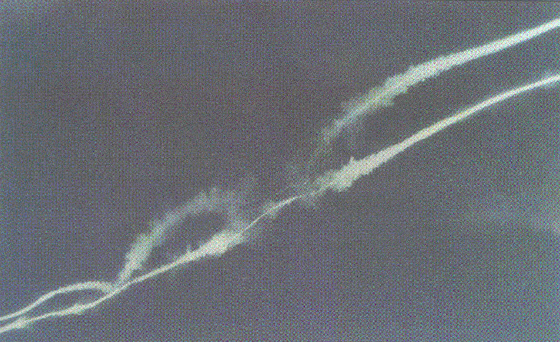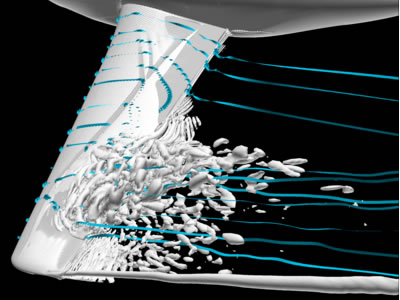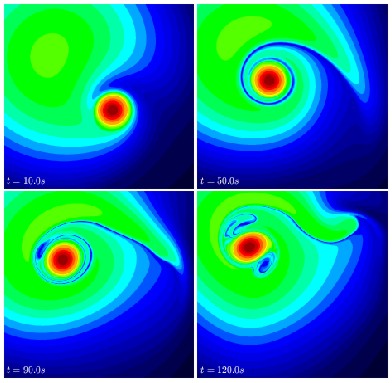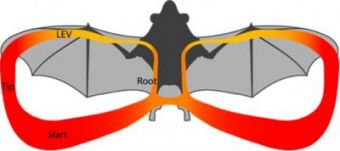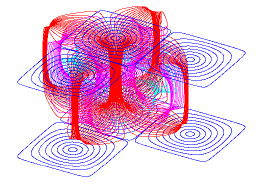Posts Tagged ‘frequencies’
Trails Seen from Space
PAGE CONTENTS
ATLANTIC OCEAN – MID-EUROPE – THE CROW INSTABILITY – MORE ABOUT VORTICES – THE 9-11 VORTEX – THE “THIRD” TRAIL – SUPERSATURATION – “GAPS” – FUEL VENTS – AIRBUS 340 RTO BRAKE TEST
Don’t forget my other pages, links and comments are one click away at the top right of the page…
ATLANTIC OCEAN
A monochrome view of the North Atlantic Ocean by AtlanticSat shows Greenland, Iceland, the British Isles, and part of Norway. Prominent in the photo is a north-south ridge of high pressure, with cold dry air to the west, and warmer wetter air to the east. Aircraft approaching or leaving this ridge have struck permanent contrail conditions on its west side. The trails are at even intervals which suggest there are only TWO great-circle routes involved (London-New York and London LAX) with regular flights from each. The stratosphere (where the trails are) is obviously moving north-to-south.
The trails peter out approaching or leaving the British Isles, where the wetter conditons don’t obtain (for a change).
Chemtrailers must ask themselves why the pilots’ aim was so poor…
MID-EUROPE
Here we are centered roughly over Hamburg; Copenhagen is right center top and the Baltic Sea further to the right. We are looking at a “triangle” of air travel activity between Kiel (center top), Berlin (bottom right) and the Rhineland (bottom left).
You can see evidence that the stratosphere is sliding along at possibly 100kph from the northwest – maybe!
THE CROW INSTABILITY
I originally thought these were local control surface vortices, but I have been better advised since, by Jay Reynolds. Thanks, Jay!
MORE ABOUT VORTICES
The Crow instability is a vortex pair instability, and typically goes through several stages:
– A pair of counter rotating vortices act upon each other to amplify small sinusoidal distortions in their vortex shapes (Normally created by some initial disturbance in the system).
– The waves develop into either symmetric or anti-symmetric modes, depending on the nature of the initial disturbance.
– These distortions grow, both through interaction from one vortex on another, and also ‘Self Induction’ of a vortex with itself. This leads to an exponential growth in the vortex wave amplitude.
– The vortex amplitudes reach a critical value and reconnect, forming a chain of vortex rings.
Initially the vortex pair falls rapidly downward. Perturbations of the vortices from the ambient atmosphere grow in a sinusoidal mutual inductance instability (the Crow instability). Eventually the vortices touch, reconnect and form vortex rings which oscillate, interact with themselves and the atmospheric turbulence and stratification, and finally dissolve. During their lifetime the rings continue to drop, giving rise to the periodic series of puffs often seen in contrail evolution.
These are spin-stabilized and follow the deflected air and take a while to spin to a stop. Ice is precipitated out of the -40 deg C water vapor in the vortex vacua. Altogether an intriguing visual phenomenon!
http://www.cerfacs.fr/cfd/wake_vortex_26.php is a useful reference…
And this low-quality video reveals…
And this high-quality video shows how far our understanding has progressed…
# A vortex (plural: vortices) is a spinning, often turbulent, flow of fluid. Any spiral motion with closed streamlines is vortex flow. …
en.wikipedia.org/wiki/Vortices
Vortices display some special properties:
* The fluid pressure in a vortex is lowest in the center (where the speed is greatest) and rises progressively with distance from the center. This is in accordance with Bernoulli’s Principle. The core of a vortex in air is sometimes visible because of a plume of water vapor caused by condensation in the low pressure of the core. The spout of a tornado is a classic and frightening example of the visible core of a vortex. A dust devil is also the core of a vortex, made visible by the dust drawn upwards by the turbulent flow of air from ground level into the low pressure core.
* The core of every vortex can be considered to contain a vortex line, and every particle in the vortex can be considered to be circulating around the vortex line. Vortex lines can start and end at the boundary of the fluid or form closed loops. They cannot start or end in the fluid. (See Helmholtz’s theorems.) Vortices readily deflect and attach themselves to a solid surface. For example, a vortex usually forms ahead of the propeller disk or jet engine of a slow-moving airplane. One end of the vortex line is attached to the propeller disk or jet engine, but when the airplane is taxiing the other end of the vortex line readily attaches itself to the ground rather than end in midair. The vortex can suck water and small stones into the core and then into the propeller disk or jet engine.
* Two or more vortices that are approximately parallel and circulating in the same direction will merge to form a single vortex. The circulation of the merged vortex will equal the sum of the circulations of the constituent vortices. For example, a sheet of small vortices flows from the trailing edge of the wing or propeller of an airplane when the wing is developing lift or the propeller is developing thrust. In less than one wing chord downstream of the trailing edge of the wing these small vortices merge to form a single vortex. If viewed from the tail of the airplane, looking forward in the direction of flight, there is one wingtip vortex trailing from the left-hand wing and circulating clockwise, and another wingtip vortex trailing from the right-hand wing and circulating anti-clockwise. The result is a region of downwash behind the wing, between the pair of wingtip vortices. These two wingtip vortices do not merge because they are circulating in opposite directions.
* Vortices contain a lot of energy in the circular motion of the fluid. In an ideal fluid this energy can never be dissipated and the vortex would persist forever. However, real fluids exhibit viscosity and this dissipates energy very slowly from the core of the vortex. (See Rankine vortex). It is only through dissipation of a vortex due to viscosity that a vortex line can end in the fluid, rather than at the boundary of the fluid. For example, the wingtip vortices from an airplane dissipate slowly and linger in the atmosphere long after the airplane has passed. This is a hazard to other aircraft and is known as wake turbulence.
Cause and effects
A wing generates aerodynamic lift by creating a region of lower air pressure above it. Fluids are forced to flow from high to low pressure and the air below the wing tends to migrate toward the top of the wing via the wingtips. The air does not escape around the leading or trailing edge of the wing due to airspeed, but it can flow around the tip. Consequently, air flows from below the wing and out around the tip to the top of the wing in a circular fashion. This leakage will raise the pressure on top of the wing and reduce the lift that the wing can generate. It also produces an emergent flow pattern with low pressure in the center surrounded by fast-moving air with curved streamlines. Wingtip vortices only affect the portion of the wing closest to the tip. Thus, the longer the wing, the smaller the affected fraction of it will be. As well, the shorter the chord of the wing, the less opportunity air will have to form vortices. This means that for an aircraft to be most efficient, it should have a very high aspect ratio. This is evident in the design of gliders. It is also evident in long-range airliners, where fuel efficiency is of critical importance. However, increasing the wingspan reduces the maneuverability of the aircraft, which is why combat and aerobatic planes usually feature short, stubby wings despite the efficiency losses.
Another method of reducing fuel consumption is the use of winglets, as seen on some modern airliners such as the Airbus A340. Winglets work by forcing the vortex to move to the very tip of the wing and allowing the entire span to produce lift, thereby effectively increasing the aspect ratio of the wing. Winglets also change the pattern of vorticity in the core of the vortex pattern, spreading it out and reducing the kinetic energy in the circular air flow, which reduces the amount of fuel expended to perform work by the wing upon the spinning air. Winglets can yield worthwhile economy improvements on long-distance flights.
Visibility of vortices due to water condensation and freezing
The cores of the vortices are sometimes visible because water present in them condenses from gas (vapor) to liquid, and sometimes even freezes, forming ice particles. The phase of water (i.e. whether it assumes the form of a solid, liquid, or gas) is determined by its temperature and pressure. For example, in the case of liquid-gas transition, at each pressure there is a special “transition temperature” Tc such that if the sample temperature is even a little above Tc, the sample will be a gas, but if the sample temperature is even a little below Tc, the sample will be a liquid; see phase transition.
For example, at the standard atmospheric pressure, Tc is 100 °C = 212 °F. The transition temperature Tc decreases with decreasing pressure (which explains why water boils at lower temperatures at higher altitudes and at higher temperatures in a pressure cooker; see here for more information). In the case of water vapor in air, the Tc corresponding to the partial pressure of water vapor is called the dew point. (The solid-liquid transition also happens around a specific transition temperature called the melting point. For most substances, the melting point also decreases with decreasing pressure, although water ice in particular—in its Ih form, which is the most familiar one—is a prominent exception to this rule.)
Vortex cores are regions of low pressure. As a vortex core begins to form, the water in the air (in the region that is about to become the core) is in vapor phase, which means that the local temperature is above the local dew point. After the vortex core forms, the pressure inside it has decreased from the ambient value, and so the local dew point (Tc) has dropped from the ambient value. Thus, in and of itself, a drop in pressure would tend to keep water in vapor form: the initial dew point was already below the ambient air temperature, and the formation of the vortex has made the local dew point even lower.
However, as the vortex core forms, its pressure (and so its dew point) is not the only property that is dropping: the vortex-core temperature is dropping also, and in fact it can drop by much more than the dew point does, as we now explain.
To a first approximation, the formation of vortex cores is thermodynamically an adiabatic process, i.e. one with no exchange of heat. In such a process, the drop in pressure is accompanied by a drop in temperature, according to the equation
Here Ti and pi are the absolute temperature and pressure at the beginning of the process (here equal to the ambient air temperature and pressure), Tf and pf are the absolute temperature and pressure in the vortex core (which is the end result of the process), and the constant γ is about 7/5 = 1.4 for air.
Thus, even though the local dew point inside the vortex cores is even lower than in the ambient air, the water vapor may nevertheless condense—if the formation of the vortex brings the local temperature below the new local dew point. Let us verify that this can indeed happen under realistic conditions. For a typical transport aircraft landing at an airport, these conditions are as follows: we may take Ti and pi to have values corresponding to the so-called standard conditions, i.e. pi = 1 atm = 1013.25 mb = 101\,325 Pa and Ti = 293.15 K (which is 20 °C = 68 °F).
We will take the relative humidity to be a comfortable 35% (dew point of 4.1 °C = 39.4 °F). This corresponds to a partial pressure of water vapor of 820 Pa = 8.2 mb.
We will assume that in a vortex core, the pressure (pf) drops to about 80% of the ambient pressure, i.e. to about 80 000 Pa.
Let us first determine the temperature in the vortex core. It is given by the equation above as

Next, we determine the dew point in the vortex core. The partial pressure of water in the vortex core drops in proportion to the drop in the total pressure (i.e. by the same percentage), to about 650 Pa = 6.5 mb. According to a dew point calculator at this site (alternatively one may use the Antoine equation to obtain an approximate value), that partial pressure results in the local dew point of about 0.86 °C; in other words, the new local dew point is about equal to the new local temperature.
Therefore, the case we have been considering is a marginal case; if the relative humidity of the ambient air were even a bit higher (with the total pressure and temperature remaining as above), then the local dew point inside the vortices would rise, while the local temperature would remain the same as what we have just found. Thus the local temperature would now be lower than the local dew point, and so the water vapor inside the vortices would indeed condense.
Under right conditions, the local temperature in vortex cores may drop below the local freezing point, in which case ice particles will form inside the vortex cores.
We have just seen that the water-vapor condensation mechanism in wingtip vortices is driven by local changes in air pressure and temperature. This is to be contrasted to what happens in another well-known case of water condensation related to airplanes: the contrails from airplane engine exhausts. In the case of contrails, the local air pressure and temperature do not change significantly; what matters instead is that the exhaust contains both water vapor (which increases the local water-vapor concentration and so its partial pressure, resulting in elevated dew point and freezing point) as well as aerosols (which provide nucleation centers for the condensation and freezing).
Condensation of water vapor in wing tip vortices is most common on aircraft flying at high angles of attack, such as fighter aircraft in high g maneuvers, or airliners taking off and landing on humid days.

Observations
A vortex can be seen in the spiraling motion of air or liquid around a center of rotation. Circular current of water of conflicting tides form vortex shapes.
Turbulent flow makes many vortices. A good example of a vortex is the atmospheric phenomenon of a whirlwind or a tornado or dust devil. This whirling air mass mostly takes the form of a helix, column, or spiral. Tornadoes develop from severe thunderstorms, usually spawned from squall lines and supercell thunderstorms, though they sometimes happen as a result of a hurricane.
In atmospheric physics, a mesovortex is on the scale of a few miles (smaller than a hurricane but larger than a tornado). On a much smaller scale, a vortex is usually formed as water goes down a drain, as in a sink or a toilet. This occurs in water as the revolving mass forms a whirlpool. This whirlpool is caused by water flowing out of a small opening in the bottom of a basin or reservoir. This swirling flow structure within a region of fluid flow opens downward from the water surface.
Instances
* In the hydrodynamic interpretation of the behavior of electromagnetic fields, the acceleration of electric fluid in a particular direction creates a positive vortex of magnetic fluid. This in turn creates around itself a corresponding negative vortex of electric fluid.
* Smoke ring : A ring of smoke which persists for a surprisingly long time, illustrating the slow rate at which viscosity dissipates the energy of a vortex.
* Lift-induced drag of a wing on an aircraft.
* The primary cause of drag in the sail of a sloop.
* Whirlpool: a swirling body of water produced by ocean tides or by a hole underneath the vortex where the water would drain out, such as a bathtub. A large, powerful whirlpool is known as a maelstrom. In popular imagination, but only rarely in reality, they can have the dangerous effect of destroying boats. Examples are Scylla and Charybdis of classical mythology in the Straits of Messina, Italy; the Naruto whirlpools of Nankaido, Japan; the Maelstrom, Lofoten, Norway.
* Tornado : a violent windstorm characterized by a twisting, funnel-shaped cloud. A less violent version of a tornado, over water, is called a waterspout.
* Hurricane : a much larger, swirling body of clouds produced by evaporating warm ocean water and influenced by the Earth’s rotation. Similar, but far greater, vortices are also seen on other planets, such as the permanent Great Red Spot on Jupiter and the intermittent Great Dark Spot on Neptune.
* Polar vortex : a persistent, large-scale cyclone centered near the Earth’s poles, in the middle and upper troposphere and the stratosphere.
* Sunspot : dark region on the Sun’s surface (photosphere) marked by a lower temperature than its surroundings, and intense magnetic activity.
* The accretion disk of a black hole or other massive gravitational source.
* Spiral galaxy : a type of galaxy in the Hubble sequence which is characterized by a thin, rotating disk. Earth’s galaxy, the Milky Way, is of this type.
# VORTEX – The Verification of the Origins of Rotation in Tornadoes Experiment or VORTEX, field projects study tornadoes. VORTEX1 was the first time scientists completely researched the entire evolution of a tornado enabling a greater understanding of the processes involved with tornadogenesis. …
en.wikipedia.org/wiki/VORTEX
THE 9-11 VORTEX
As explained previously, vortices that come into contact with each reconfigure each other, regenerating intermediate “rings”, and ALL vortices will “stick” to a plane surface – like the ground (tornado), or the face of a building (World Trade Center Tower 2).
The Boeing 767, weighing around 180,000 kilograms and traveling at 260 meters/second, was pulling up in about a 2G banking turn before it struck the tower, so the energy it was putting into its (invisible) WAVE VORTEX was twice the normal, it occurred to me, so might not there be EVIDENCE of its existence in the smoke and dust after the collision?
Evidence there is, in embarrassing plenty. Embarrassing for “no-planers”, anyway, if they were to be well-informed and curious enough to CONTINUE TO WATCH after the collision took place. An oxymoron, I think.

Check back to confirm this if you like…
So now “no-planers” would HAVE to claim that the video artists that “falsified” these images were experts in aerodynamics as well.
To which the answer is OCCAM…
.
THE “THIRD” TRAIL…
In this case the fifth… is the trail left by the APU (Auxiliary Power Unit) which is a normal (but small) gas turbine/electrical generator set. As with the main engines, it burns kerosine to form carbon dioxide and steam. As with the main engines, it leaves a trail. But where’s it coming from?
SUPERSATURATION
“the whole plane is spraying”
When stratospheric air is very clean and stable it may contain MORE water vapour than it does when it is described as having 100% Relative Humidity. The slightest disturbance to it will cause ice crystals to precipitate out of it. It cannot go into super-saturation if there are ANY nucleative materials of any sort in this air.
Here is just such a case, which occurs on occasion in the sub-tropical stratosphere. The trail forms by “burst condensation” into super-cooled droplets which are microscopic initially and can refract sunlight by interference. Over a small space of time these droplets grow progressively as water vapor deposits more supercooled water into them. As they progressively increase their size they run through a progression of light frequencies which they interfere with. This is NOT a refraction effect.
Chemtrailers claim the colors to be indicative of “foreign materials” which is quite the reverse of the truth; only pure water will do this, and only pure air will have become supersaturated in the first place.
The fact that in supersaturated conditions, large aircraft can place thousands of tons of ice into the stratosphere is covered by the paper “Contrails to Cirrus” mentioned in the INTRODUCTION page.
https://jazzroc.wordpress.com/2008/11/22/01-compendium/
“GAPS”
“Gaps” are claimed by chemtrailers as “evidence that planes are spraying”. Such gaps will of course appear in any persistent contrail where the stratospheric air RH falls below 100%. Generally, of course, the humidity tails off gradually, and the transition of trail-to-no-trail is quite indistinct.
In THIS case, the “transition” is a hard and sharp right angle. Too sharp, in fact, for a whirling twin-vortex contrail… Close inspection of the “sky” each side of the “gap” shows it to be comprised of a chemtrailer’s vertical “airbrush strokes”! Naughty!
FUEL VENTS
Here we have an aircraft actually spraying something; it’s fuel. If some in-flight emergency occurs and the plane must make a quick landing, it must first lose weight, for it cannot land at its take-off weight. Some of its fuel must GO.
Chemtrailers are quick to claim this shot as “spraying evidence”.
![]()
Written by JazzRoc
November 20, 2008 at 1:00 am
Posted in atmosphere, Aviation, contrails, science, Truth
Tagged with aerosol, aileron, air, airbrush, aircraft, airflow, aluminium, aluminum, apu, arthritis, atlantic, atlanticsat, autopilot, auxiliary, barium, berlin, breathing difficulties, british, burst, carbon dioxide, carnicom, chem trail, cold, condensation, condition, contrail, control, copenhagen, correction, crystals, deflected, dry, emergency, europe, evidence, filaments, frequencies, Gas, generator, great-circle, greenland, hamburg, heavy haze, high, humidity, ice, iceland, in-flight, interference, isles, kerosine, kiel, lax, light, lines in the sky, london, lung disease, material, metallic salts, microscopic, morgellons, movement, new york, no more blue skies, norway, not a normal cloud, nucleative, ocean, oily clouds, phenomenon, photo, power, precipitate, precipitated, pressure, ptb, refraction, relative, rense, rhineland, ridge, route, satellite, space, spin-stabilized, spraying, steam, stratosphere, stratospheric, sub-tropical, super-cooled, supersaturation, tic-tac-toe, trail, Turbine, twin-vortex, unit, unnatural cloud, vacua, vapor, vapour, vortex, vortices, warm, water, webby material, wet, whiteout

